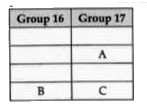The position of three elements X, Y and Z in the periodic table are shown below:
(i) Which type of ion, cation or anion, will be formed by element X ?
(ii) Which element, Y or z, has the atom of comparatively larger size ?
Give reason in each case.
 Solution in Kannada
Solution in Kannada
(i) The valency of X is one. It has tendency to lose one electron. Therefore, X will form cation.
(ii) Y, because atomic radius decreases across a period due to increase in the electrostatic force between electrons and nucleus.
Topper's Solved these Questions
- PERIODIC CLASSIFICATION OF ELEMENTSBOOK - OSWAAL PUBLICATIONCHAPTER - PERIODIC CLASSIFICATION OF ELEMENTSEXERCISE - TOPIC:2- SHORT ANSWER TYPE QUESTIONS-II
45 Videos
- PERIODIC CLASSIFICATION OF ELEMENTSBOOK - OSWAAL PUBLICATIONCHAPTER - PERIODIC CLASSIFICATION OF ELEMENTSEXERCISE - TOPIC:2- LONG ANSWER TYPE QUESTIONS
5 Videos
- PERIODIC CLASSIFICATION OF ELEMENTSBOOK - OSWAAL PUBLICATIONCHAPTER - PERIODIC CLASSIFICATION OF ELEMENTSEXERCISE - TOPIC:2- VERY SHORT ANSWER TYPE QUESTIONS
18 Videos
- METALS AND NON-METALSBOOK - OSWAAL PUBLICATIONCHAPTER - METALS AND NON-METALSEXERCISE - NCERT CORNER (Textbook Exercises)
16 Videos
- SOLVED PAPER SSLC KARNATAKA APRIL 2019 BOOK - OSWAAL PUBLICATIONCHAPTER - SOLVED PAPER SSLC KARNATAKA APRIL 2019 EXERCISE - QUESTIONS
49 Videos
Similar Questions
The atomic numbers of two elements A and B are 11 and 12 respectively. Which element exhibits highest metallic property ? Why ? Write the molecular formula of the compounds formed when these elements combine with the element 'Z' having atomic number 8.
View SolutionExamine the elements of the third period and classify them as metals or non-metals. Comment on the metallic and non-metallic character of the third period. Name the most metallic element and non-metallic element of this period.
View SolutionAn element has atomic number 3. To which period of the periodic table does it belong?
View SolutionWhich of the following is double displacement reaction ?
View SolutionThe change that occurs in the eye to see the distant object clearly is
View SolutionThe atomic numbers of the three elements X,Y and Z are 2,6 and 10 respectively
(i) Which two elements belong to the same group?
(ii) Which two elements belong to the same period?
Given reasons for your choice.
View SolutionThe position of three elements A, B and C in che periodic table are shown below : (a) State whether A is metal or non-metal. (b) Seate whether C is more reactive or less reactive than A. (c) Will C be larger or smaller in size than B ? (d) Which type of ion, cation or anion will be formed by the element A ?
View SolutionThe position of three elements A, B and C in the periodic Table is shown below:

(a) State whether A is a metal or non-metal
(b) State whether C is more reactive or less reactive than A
( c) Will C be larger or smaller in size than B?
(d) Which type of ion, cation or anion, will be formed by element C?
View SolutionThe position of three elements A, B and C in the Periodic Table are shown below: (a) State whether A is a metal or a non-metal. (b) State whether C is more reactive or less reactive than A. (c) Will C be larger or smaller in size than B? (d) Which type of ion-cation or anion will be formed by element A?
View SolutionThe position of three elements A, B and C in the Periodic Table is shown below:

Giving reasons, explain the following:
(i) Element A is a metal.
(ii) Element C has larger size than element B.
(iii) Element B has a valency of 3.
View SolutionThree elements X, Y and Z have atomic numbers 7, 10 and 14 respectively.
(i) Identify the group number of these elements in the periodic table.
(ii) Mention one unique feature each of elements Y and Z.
(iii) Which of the above two elements belong to the same period ?
View SolutionThe position of three elements A, B and C in the periodic Table is shown below: (a) State whether A is a metal or non-metal (b) State whether C is more reactive or less reactive than A ( c) Will C be larger or smaller in size than B? (d) Which type of ion, cation or anion, will be formed by element C?
View SolutionThere are three elements X, Y and Z having atomic numbers of 6, 16 and 19 respectively. Based on this information, Het has been asked to answer the following questions:
In which group of the periodic table would you expect to find (i) element x (ii) element Y and (iii) element z?
View SolutionThe position of three elements A, B and C in the periodic table are as shown below: Which type ion, cation or anion, will be formed by elements A ?
View SolutionElements W, X, Y, Z in the periodic table are shown below: State whether W is smaller or larger than Z in size
View Solution
